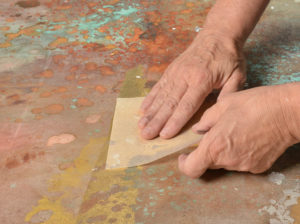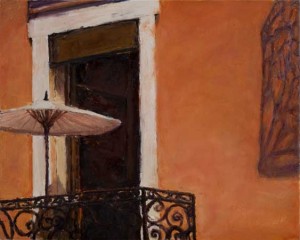Dear Artist,
Around 1723, Johann Sebastian Bach composed his Two-and-Three-Part Inventions, the keyboard exercises he wrote for his students and his growing brood of kids. Bach described these call-and-answer, contrapuntal inventions as a means of obtaining and carrying out good ideas by learning to play clearly separate voices. Wanting to give his students a taste of how to build compositions, Bach arranged the Inventions in progression, ascending in major and minor keys. The result is a structure that serves as a backbone for understanding the melodic variation possible while hinged on one musical theme.

Hollywood Africans (1983)
Acrylic and oil stick on canvas
84 1/16 x 84 inches
by Jean-Michel Basquiat (1960-1988)
Around 2003, 17-year-old future composer and bandleader Jon Batiste left his musical family and band in Kenner, Louisiana to study piano at the Juilliard School in New York City. Wanting to develop uniquely from the New Orleans influences and styles of his upbringing, Jon searched for something he had not quite identified, he admits, knowing only that he wanted to “go out and risk failure apart from the community that knew me.” One evening at a jam, Jon heard a composition by Thelonious Monk, performed by a band in the vibe and flavour Jon knew he’d been searching for in his own playing. Full of dissonance, question-and-answer, articulation and pathos, the composition struck Jon with the realization that here was an artist who “had cultivated a sound that I was intuitively reaching for, 50 years before I existed — I didn’t even know that what I was reaching for had already been developed.” And there began the evolution of Jon’s own sound and style, with Monk at the centre as forefather.
Here are a few ideas for finding your own “sound,” whether at the piano, the easel or somewhere else inventive:
Make phrases that ask questions. Then try to answer them.
Leave space, let things ring out and become filled with new implications.
Find artists you can return to for inspiration, while developing your own contemporary tone and articulation.
Think of a place and put yourself in the story. Be authentic when conveying an emotion and vibe.
Set the scene and feel the urgency of what’s going on and what’s going to happen.
Keep nostalgia subtle, so that it can give you excitement without being overwhelming. Avoid hysterics, opting instead for what Jon calls “an intelligent excitement.”
Be conscious, then unconscious, about your reference and explorations.

A Panel of Experts (1982)
Acrylic and oil stick and paper collage on canvas with exposed wood supports and twine
60 × 60 inches
by Jean-Michel Basquiat
Sincerely,
Sara
PS: “You can only be what you are.” (Jon Batiste)
Esoterica: “There’s so much there,” says Jon, when describing Bach’s sound. “Bach is the mysticism of music, the spirituality of music.” According to Jon, Bach was able to be so systematic, logical and symmetrical because of a kind of musical game he played that harboured a depth of human feeling and a range of human emotions. He believes Bach was asking questions in his music about the afterlife. “It makes you realize what’s possible,” says Jon. “He’s arguably the best at a thing that anyone’s ever been in the history of doing a thing.”
Jon Batiste’s 2018 album Hollywood Africans, named after the painting by Jean-Michel Basquiat is available on Amazon, here.
J.S. Bach’s Two-and-Three-Part Inventions is available on Amazon, here and here.
Terry Gross’ 2018, at-the-piano interview with Jon Batiste on NPR is here.
 “Question, answer and all of a sudden moving, just two melodies playing, a conversation, call and response, harmony and dissonance. That’s life, that’s our journey; exemplified in a single piece that he wrote for his kids.” (Jon Batiste, describing Bach’s Two-and-Three-Part Inventions.)
“Question, answer and all of a sudden moving, just two melodies playing, a conversation, call and response, harmony and dissonance. That’s life, that’s our journey; exemplified in a single piece that he wrote for his kids.” (Jon Batiste, describing Bach’s Two-and-Three-Part Inventions.)
Featured Workshop
Traditional Japanese mineral pigment painting with Judith Kruger. Make water-based paint from cured shells, minerals, soils, pine soot, indigo and cochineal with natural glue. Learn to stretch Kumohadamashi paper and prepare wood panels. Metallic leafing and oxidation techniques will be covered. Emphasis on the creation of purposeful, multi-layered paintings stemming from ancient practices that embody the power to nurture the spirit. Historical information and powerpoint presentation included. Traditional and abstract painters are welcome. All levels.
More info on http://www.judithkruger.com
Featured Artist
I am a painter. I am delighted to be a painter.







7 Comments
Wonderful letter. Deeply inspiring. I love making order in my art, and don’t encounter kindred spirits often enough!
Thank you, Sara. I’m not an artist, just a longtime Genn reader. This letter is so stimulating, its ideas can be taken up and applied obliquely to a much wider range of action and interraction. It’s wide-awake time!
This was wonderful, thank you so very much. I need to listen carefully, start asking and answering questions and keep on keeping on. Great inspiration here!
I read this post last evening and have been thinking about it since….so I wrote a little haiku as catharsis….
Juvenile Doodles
Have supplanted real talent
Pyrrhic Victory
NYC has given us as much trash as treasure. Too bad we find it so difficult to determine difference. On a positive note….even the most marginal have a chance at the golden ring if they can convince the right people to invest in them. It’s all a matter of perception….
Sara, I love your letters and Robert’s letters. But sometimes I have absolutely no idea what the letter is about. This is one of those times. I hope that is okay.
Cheers,
Verna
Wonderful, words, music, images. Thank you, Sara… I am mid-stream attempting to modernize my paintings,,, it’s a big gap from Bach to Batiste… !
The melody is hidden in all sound… the design in all nature and things….You encourage me to keep digging for gold in my own mine (mind). So timely, so thought provoking right now….
Hi Sara. I like this letter, titled,”Themes and Variations.” I think it describes the way artists (Painters, Writers, Musicians) think. Or, even as helpful guidance in creating. From Bach to Batiste to Basquiat …. interesting and inspiring. Thank you!